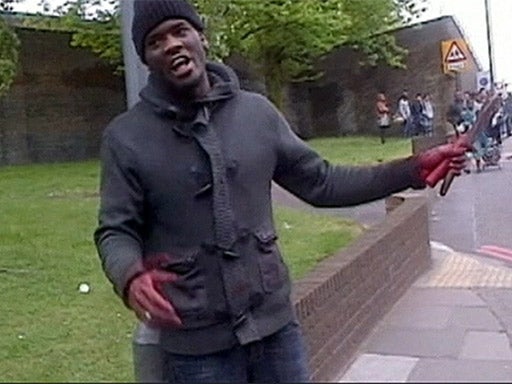Lee Rigby murder report: How MI5 latched on to – and lost – the man who later murdered soldier
The MPs’ report gives a fascinating – and disturbing – glimpse of the way the security services work

Michael Adebowale made no attempt to hide his rage or his thirst for revenge in his online conversation with a jihadi leader in Yemen. Because of murders of Muslims, as he put it, by the British military in Iraq and Afghanistan, he would execute a British soldier.
During the chat on Facebook the senior member of al-Qaeda in the Arabian Peninsula (Aqap), codenamed “Foxtrot” by MI5, was encouraging the British would-be killer, suggesting a choice of weapons and discussing the challenges in being a martyr. He asked Adebowale to keep him abreast of developments.
The exchange took place in December 2012, but it did not surface until after Fusilier Lee Rigby was butchered outside Woolwich Barracks five months later. The social network had not passed the conversation, including the phrase “let’s kill a soldier”, to British security agencies.
The Intelligence and Security Committee (ISC) was scathing about the failure to do so, saying the information could have saved the 25-year-old soldier’s life. But Adebowale and fellow Muslim convert Michael Adebolajo had already been on the radar of MI5 and the police for years by the time they committed their savage murder. And in that time, the ISC report charted, a number of mistakes had been made by MI5 as well as the police and MI6.
Adebolajo came to the notice of the security service in 2008 when he was thought to have acquired equipment for a terrorist attack and held meetings with a member of al-Qaeda. A desk officer recommended that data should be acquired from his telephone, his digital footprint established and his home address found. None of these recommendations were carried out. No action was taken either over his links to Al Muhajiroun, a proscribed organisation.
Two years later, at a time he had been assessed to have been of only low level interest, Adebolajo was arrested by police in Kenya as he was trying to cross into Somalia to join the Islamist group al-Shabaab. Neither MI6 – otherwise known as the Secret Intelligence Service or SIS – or MI5 were aware that he had travelled to east Africa, and MI6’s subsequent inaction led to strong criticism from the ISC.
“The committee finds the SIS’s apparent lack of interest in Adebolajo’s arrest deeply unsatisfactory,” it said. “SIS’s role in countering ‘jihadi tourism’ does not appear to have extended to any practical action being taken. SIS must ensure their procedures are improved so that this does not happen again.”
Adebolajo was interviewed by Scotland Yard when he returned from Kenya. He complained of being threatened with electrocution and rape. The ISC criticised MI6 for not addressing the complaints and also MI5 for waiting four months to start an investigation. “We note our concern at the four-month delay in opening an investigation into Adebolajo following his return from Kenya. Where an individual is believed to have been seeking to join a terrorist organisation overseas, there should be no such delays.”
Adebolajo was to claim subsequently that MI5 had begun to harass him while trying to recruit him as an informant. Members of his family and friends say this tipped him over the edge into murderous violence. The ISC report did not deal with the recruitment issue in the report on “security grounds”. On the allegation of harassment, it maintained: “We have investigated all aspects of MI5’s actions thoroughly and have not seen any evidence of wrongdoing by MI5 in this area.”
But while MI5 were trying to “turn” Adebolajo, they had not kept track of the people he had been seeking abroad. The failure to follow up on the 2008 recommendation to monitor his communications meant they failed to monitor his developing links with two Aqap members. One of them – a “Tier 1 Subject of Interest” codenamed SOI CHARLIE – may, according to reports in Islamist circles, have been Ahmed al-Awlaki, the American-born “Bin Laden of the Internet” who was eventually killed in a Drone strike after an intensive hunt by the CIA.
The ISC said: “It was a mistake on MI5’s part not to seek the content of Adebolajo’s 2008 communication with an individual of interest who later became a high-profile and senior Aqap extremist.” However, it accepted MI5’s own assessment that “it would not have had an impact on the case”.
Michael Adebowale came to MI5’s attention in 2012, partly through his interest in the jihadist online magazine Inspire, which al-Awlaki had helped to found. In time he too had contacted SOI CHARLIE, Adebolajo’s online al-Qaeda contact.
GCHQ tracked the connection but failed to pass this on to MI5. As a result the extent of the risk being posed by Adebowale was not logged and his link, through al-Qaeda, with Adebolajo was not noted. The ISC said: “GCHQ’s failure to report an item of intelligence which revealed contact between… Adebowale and the Aqap extremist CHARLIE was significant. It would have led to different investigative decisions.”
Until now, GCHQ has been provided with the contents of six of Adebowale’s online accounts by the US’s National Security Agency, but five others have yet to be delivered.
A year and half on, gaps still remain in the narrative behind Fusilier Rigby’s terrible death.
Join our commenting forum
Join thought-provoking conversations, follow other Independent readers and see their replies
Comments